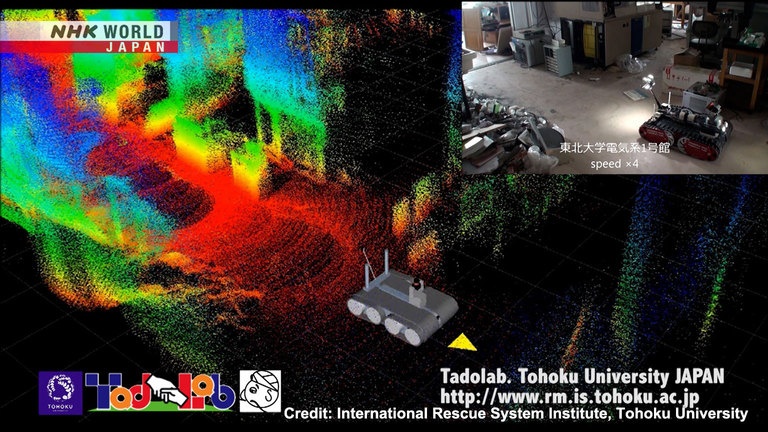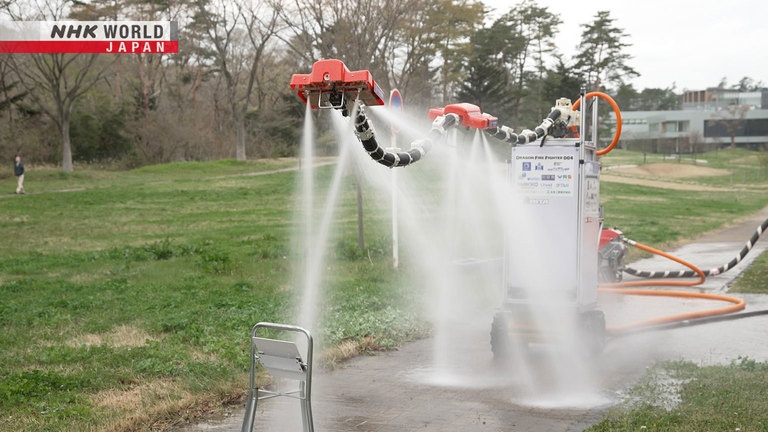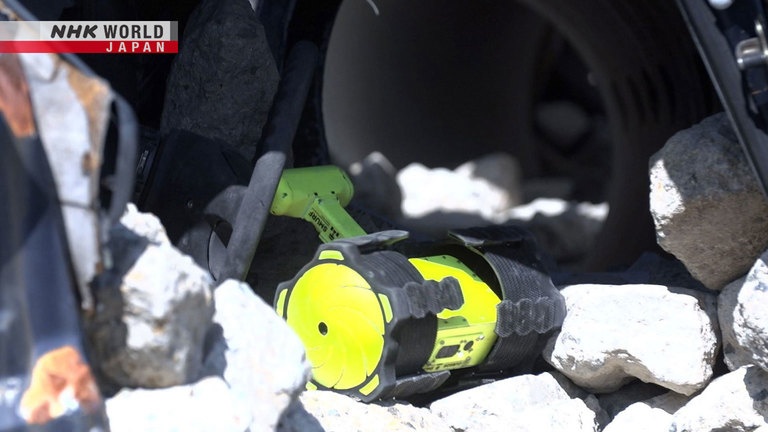#17 Disaster Response Robots
The Great East Japan Earthquake in 2011 and its resulting tsunami caused the accident at the Fukushima Daiichi Nuclear Power Plant. The worst nuclear accident in Japan's history suffered from a lack of information due to the inaccessibility of the reactor buildings. For this reason, "disaster response robots" were deployed to take pictures and measure radiation doses inside the buildings. In the aftermath of a major disaster like that as well as an earthquake or fire, robots can quickly enter dangerous sites that are inaccessible to humans, find people in need of rescue, and take detailed measurements to provide data about the site. In this episode, we'll look at the latest developments among Japan's "disaster response robots."




Transcript
Japan has a long history of natural disaters.
Now, the power of science is helping to overcome them.
BOSAI: Science that Can Save Your Life.
Hi, I'm Lemi Duncan.
27 years ago in 1995, the city of Kobe was severely damaged by a major earthquake.
Buildings and houses collapsed, and many people were trapped under the rubble.
The powerful 7.3-magnitude earthquake, completely destroyed about 105,000 houses, and left many people unaccounted for.
Despite their best efforts, it was difficult for rescue workers to find survivors in the wreckage.
In the aftermath of the earthquake, it was dangerous to enter buildings, as they might collapse and cause further loss of life.
The earthquake claimed 6,434 victims.
About 80% of them died from being crushed or suffocated in collapsed buildings.
Since then, disaster response robots that can enter dangerous places to find people in need of rescue have been developed.
In today's episode, we'll take a look at the latest disaster response robots.
Located about 20 kilometers from Kobe, this is one of Japan's largest disaster preparedness facilities.
Here, robots are being developed for various disaster scenarios.
One of these robots, called Quince, was developed as a result of the Kobe earthquake.
Quince is equipped with several cameras, and not only assists in rescue efforts, but also surveys the disaster site.
It uses a laser scanner to create a 3D map, and transmits information remotely.
Hello.
Hello. Nice to meet you.
This is Doctor Satoshi Tadokoro, who developed Quince.
Tadokoro was working on industrial robots at Kobe University when the earthquake occurred 27 years ago.
This prompted him to start conducting research on the use of robot technology to help victims of disasters.
Development of Quince began in 2006.
Learning lessons from the Kobe earthquake, he developed various functions that would be useful in a disaster area.
Ok, please start the robot.
Oh, it climbs up there very smoothly.
One of the difficulties faced by robots at disaster sites is the large amount of debris that is found in many areas.
High mobility is required to move through the debris without stopping.
That's why Quince is equipped with four sub-tracks, at the front and rear.
In order to climb the debris, the sub-tracks are moving up and down,
adjusting to the terrain as they move along.
As you can see, it can go up and down a staircase smoothly.
When it arrives at its destination, Quince will survey the interior of the building and search for survivors.
That's exactly what was required of a robot at a disaster site.
A rescue captain said to me: "We have the ability to rescue people,
but we don't know where they are."
"That's the big problem."
We are trying to solve that problem
with robots like Quince.
It has cameras attached all over.
Yes, it has cameras and gas sensors,
which can be used to examine a building interior.
These give it more functionality.
Quince is equipped with various sensors that measure substances in the air.
For example, it can measure the concentration of carbon dioxide to help locate survivors.
Cameras are mounted in three locations: front, rear, and overhead.
These transmit real-time video of the surroundings.
In addition, it uses a laser scanner to gather information on the surrounding environment while moving around the disaster site.
From this, a three-dimensional map is immediately created, to help visualize the situation.
Walls, debris, and other obstacles are identified and shown in different colors.
In 2011, five years after Tadokoro started its development, Quince was deployed to an actual disaster site for the first time.
A massive earthquake with a magnitude of 9.0 struck the Tohoku region of eastern Japan, causing a huge tsunami.
It hit the Fukushima Daiichi Nuclear Power Plant, causing a meltdown of the nuclear fuel in the reactor, leading to the worst nuclear accident in Japan's history.
First of all, we needed to know what was going on inside the reactor, but the radiation level was too high for humans to enter, and the situation was out of control.
Quince was the only one that could go in and gather information.
These are video images sent by Quince when it entered the reactor.
The area was littered with debris and the humidity was 98%.
However, Quince was able to get up to the second floor and successfully transmit images of the building interior.
It also succeeded in checking the level of radioactivity and creating a detailed map of the area.
The detailed information from inside the reactor, that could only be gathered by Quince, made a major contribution to the subsequent effort to cool the reactor core.
To be honest, I didn't know if it would work or not.
I was very happy to hear that it went so well.
I'm glad I was doing this research then.
With the success of Quince, disaster response robots have proven their effectiveness.
Today, even more advanced robots are being developed.
For example, exploration robots that can penetrate small gaps in rubble that are too small for a robot the size of Quince, a robot that can fight fires at sites
that are too dangerous for people to enter.
I will visit the laboratory of Dr. Tadokoro, who is developing next-generation disaster response robots using the latest technology.
Is this the robot you're developing now?
It's a snake-shaped robot
called an Active Scope Camera.
With its long string-like shape,
this robot can slither into debris.
Many people become trapped under the wreckage of houses and buildings that have collapsed in a disaster.
In general, the survival rate declines significantly after three days, and Tadokoro is developing this robot in order to find survivors as quickly as possible.
We were shown how it actually gets into the gaps in the rubble to search for them.
Oh, it's moving forward!
How does it do that?
The driving force is generated by
vibrating cilia on the robot's surface.
It's making a hissing noise.
That's the air jet.
Oh, now it's floating!
We can use a jet of air
to raise the robot's head.
Air is blown downward from the head of the robot, so it lifts up.
The direction and force of the air jet are controlled by computer, to move the robot in the desired direction.
The tip is equipped with a camera and light.
It can be remotely controlled to search for those in need of rescue, while checking the inside of a building.
A victim's voice is key to their being found.
Audio processing technology removes noise from the surroundings and the movement of the robot, and extracts and enhances just the person's voice.
Help me!
To further increase the length of the snake robot, they are currently working on reducing its weight.
We were also given a special look at another robot currently under development.
This is an upgrade of the snake robot, used for a different purpose.
Ok, please start it up.
Oh, there's lots of water coming out.
It's going up!
It's quite powerful, isn't it?
This is the Dragon Firefighter.
It extinguishes fires, while floating in the air using the force of its water jets.
Using the camera to change the angle of the nozzles and move the head, water can be sprayed at the target location.
For example, if there's a fire in a high-rise building, this robot can enter through the window,
go right inside and put out the fire.
By applying water directly,
you can extinguish the fire efficiently.
I see.
The EU has taken notice of Tadokoro's ability to develop original robots.
In 2020, he was asked to participate in an international joint research project under the EU's Horizon 2020 science and technology research program
to develop a new, original disaster response robot system.
The idea is to fly drones into disaster sites that humans cannot enter, and drop small robots from the sky.
The small robots then penetrate the rubble, to search for trapped victims.
Tadokoro was asked to research and develop a small robot that could be dropped from a drone.
The small robot named SMURF needs to be durable enough to withstand the impact of a drop.
To achieve this, Tadokoro took on the challenge of reducing the weight of the Smurf.
The target weight is 1.5 kilograms.
The latest field of research is called "soft robotics,"
where the robot has a soft body rather than a hard body.
By using a soft body with flexibility, like an octopus, we are trying to develop something
that has not been possible before.
This is the second version of the SMURF.
The track has a soft structure
that adapts itself to the debris, and can generate high driving force with good grip.
The soft track certainly adjusted to the terrain, increasing the driving force.
Development is underway, with a goal of 2023.
Tadokoro is also developing a variety of other robots, including a drone for inspecting infrastructure, and a fire-resistant robot hand to grasp very hot objects in fires.
He's passionate about developing effective disaster response robots.
What do you most want to achieve
with your disaster response robots?
Disasters will never go away.
We cannot eliminate earthquakes.
But we should try to minimize the damage,
which is where robots can be useful.
I hope to create a world where
no one is lost in a disaster.
I was really moved by the commitment, unity, and drive of the developers to make disaster response robots.
I expect that many more disaster response robots will be developed in the future, and they will play a crucial role in saving lives when disasters occur.